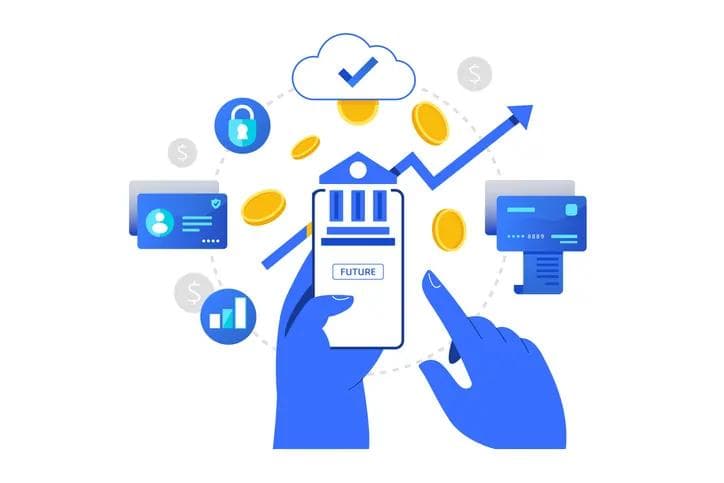Next-Gen Bank Branches: The Evolution from Transaction Hubs to Experience Centers
Next-Gen Bank Branches: The Evolution from Transaction Hubs to Experience Centers
Published by Jessica Weisman-Pitts
Posted on April 28, 2025

Published by Jessica Weisman-Pitts
Posted on April 28, 2025

The traditional bank branch, once defined by long teller lines and routine transactions, is undergoing a major transformation. Rather than closing physical locations entirely, leading banks—including JPMorgan Chase, Bank of America, and Wells Fargo—are investing hundreds of millions of dollars into redesigning branches as modern experience centers. This change reflects a new reality: while digital banking meets demand for speed and convenience, consumers still seek personalized service and trusted human interaction—needs that reimagined branches are designed to meet.
The Great Banking Reset
As digital banking becomes more widespread, a new trend is reshaping the industry: many customers still value personal interaction alongside digital convenience. The reduced emphasis on routine transactions is prompting banks to rethink the role of physical branches. Industry projections show that by 2026, 61% of banking services will be digital, while 39% will remain human-assisted. Rather than choosing between digital and physical channels, banks are redesigning their networks to blend technology with human service, creating a more connected and flexible experience for customers.
The New Branch Philosophy
Modern bank branches are being designed with three core principles in mind:
1. Experience Over Transaction
Bank branches are no longer defined solely by deposits and withdrawals. Instead, branches are evolving into hybrid spaces where technology and human expertise blend to create meaningful relationships. The modern branch experience focuses on delivering personalized advice, building trust, and offering services that are difficult to replicate online, such as complex financial consultations and community engagement events. Transactions still happen, but they are no longer the primary reason customers visit — the emphasis has shifted to creating lasting connections and enhancing the overall customer journey.
2. Community Integration
Banks are increasingly positioning branches as anchors within their communities, providing services that extend beyond traditional banking. JPMorgan Chase has pioneered this approach with its Community Center branches, which are larger locations strategically placed in low- and moderate-income neighborhoods. These centers serve multiple purposes: they offer financial education workshops, provide resources for small business owners, host community events, and create welcoming spaces designed to foster economic empowerment. By integrating deeply into local communities, banks are redefining the physical branch as a catalyst for broader financial inclusion.
3. Technology as an Enabler
Technology is playing a critical role in reimagining the physical branch experience. Digital consultation rooms, interactive screens, and virtual banking assistants are helping bridge the gap between online and in-person banking, allowing customers to access self-service tools while still having immediate access to human expertise when needed. Rather than replacing human interaction, these technologies enhance it—making financial services more accessible, efficient, and personalized within the branch environment.
Key Features of Next-Gen Branches
The Welcome Zone
The traditional teller counter is disappearing, replaced by open-concept welcome areas inspired by high-end retail and hospitality design. Banks like JPMorgan Chase, Citibank, and Bank of America are taking cues from brands such as Starbucks and Aesop, creating spaces that feel more like community lounges than financial institutions. These redesigned branches feature casual seating, soft lighting, and open floor plans aimed at making customers feel comfortable and welcome, encouraging longer visits and deeper engagement.
Digital Integration Zones
Modern branches are creating dedicated digital areas that offer interactive teller machines, video banking capabilities, and self-service digital screens. These tools allow customers to perform routine tasks—such as deposits, withdrawals, account inquiries, and bill payments—quickly and independently. At the same time, staff members remain available to assist when needed, ensuring a seamless transition between self-service convenience and personalized support for more complex needs.
Consultation Spaces
Private meeting rooms equipped with advanced technology—such as secure video conferencing tools, digital document signing capabilities, and interactive displays—allow banks to offer both in-person and virtual consultations. These spaces enable seamless transitions between digital and physical interactions, providing customers with flexibility in how they engage with complex financial services such as mortgage planning, investment advice, or small business banking. By integrating technology into private consultation spaces, banks can maintain personalized service while expanding access and convenience.
Community Areas
Modern branches are increasingly designed to serve as community hubs that encourage involvement and support local engagement. These multi-purpose spaces often host financial literacy workshops, community meetings, and co-working opportunities for small business owners. By expanding their role beyond traditional financial services, banks are fostering stronger relationships with the neighborhoods they serve.
The Human Element in a Digital Age
One of the most important aspects of branch transformation is the evolving role of staff. In the bank of the future, employees are being retrained to serve as financial advisors, technology guides, and community liaisons, moving beyond transactional tasks to focus on building long-term customer relationships. By developing broader skills, branch employees can provide personalized advice, assist customers with digital tools, and strengthen the bank’s role as a trusted community partner.
The New Banking Professional
Today's banking professionals are expected to bring a broader and more dynamic skill set to their work. They must be:
Technology Integration
New technologies are reshaping the role of bank branches, focusing on both operational efficiency and customer service. Beyond traditional transactions, branches are introducing biometric authentication, AI-driven advisory tools, and video-enabled consultations. These technologies allow banks to improve security, streamline routine services, and offer more flexible ways for customers to interact with financial specialists—whether in person or remotely.
Smart Authentication
Biometric technologies such as facial recognition and fingerprint scanners are becoming standard, providing banks with more secure and seamless methods of customer identification. These tools not only enhance branch security but also simplify the customer experience by reducing the need for traditional authentication processes like PINs or passwords.
AI-Powered Insights
Artificial intelligence is increasingly being integrated into bank branches to enhance customer service and operational efficiency. The Commonwealth Bank of Australia employs AI-powered chatbots within its branches to handle a significant volume of customer inquiries, providing real-time, context-aware responses. Signature Bank of Georgia uses AI-driven software to detect fraudulent checks, analyzing multiple features to improve fraud prevention measures. JPMorgan Chase also leverages AI to personalize customer interactions, helping guide clients toward suitable financial products and services. These implementations demonstrate how AI is actively transforming the in-branch banking experience.
Interactive Technology
Digital video tellers and interactive screens are becoming more common in modern bank branches, allowing customers to complete transactions, access services, and connect with specialists remotely. DBS Bank in Singapore has deployed Video Teller Machines (VTMs), enabling customers to conduct real-time video consultations outside of traditional banking hours. Emerico's X-series Virtual Teller Machines are also being used in UAE banks to automate customer service through AI-driven interactive kiosks. These innovations demonstrate how technology is reshaping the in-branch banking experience.
The Business Case for Branch Transformation
While digital banking offers significant cost advantages and efficiency, physical branches continue to play a critical role in customer engagement and business growth. Transformed branches are not simply about maintaining a presence—they create opportunities to build trust, deliver complex financial services, strengthen brand identity, and foster deeper, more personal relationships with customers.
Building Trust and Loyalty
Research shows that meaningful human interactions in banking lead to higher customer satisfaction and loyalty. Physical branches provide customers with a trusted environment to discuss complex financial matters, seek personalized advice, and build long-term relationships—elements that digital-only channels often struggle to replicate.
Complex Product Sales
While routine banking tasks increasingly shift to digital channels, physical branches remain essential for delivering complex, high-value financial services. Mortgages, investment management, business banking solutions, and wealth advisory services often require detailed discussions, personalized recommendations, and a level of trust that is difficult to replicate online. Face-to-face consultations help customers navigate significant financial decisions with greater confidence and support.
Brand Differentiation
As banking becomes increasingly digital, branches provide banks with a rare opportunity to express their brand physically. The goal is to transform branches from transaction-type models to experience centers that resonate with a new generation of consumers. Through their layout, design, and service model, branches can reinforce a bank’s identity, communicate its values, and offer customers a tangible experience that digital channels alone cannot deliver.
Emerging Trends
Several trends are shaping the next wave of branch transformation:
The Future of Branch Banking
The transformation of bank branches is no longer about survival—it's about adaptation and growth. As digital channels continue to handle an increasing share of routine transactions, physical branches are being reimagined to serve more strategic roles. Tomorrow’s branches are designed not simply as transaction points, but as experience centers—spaces that foster meaningful human connections, provide personalized financial guidance, and anchor the bank's presence within the community.
Through thoughtful integration of technology, sustainable design, personalized services, and new experiential models, banks are redefining how they connect with customers in an increasingly digital world. The institutions that succeed will be those that recognize the enduring value of the physical branch—not as a relic of the past, but as a vital platform for building trust, deepening relationships, and delivering financial services in ways that are human, flexible, and future-ready.
Explore more articles in the Banking category











